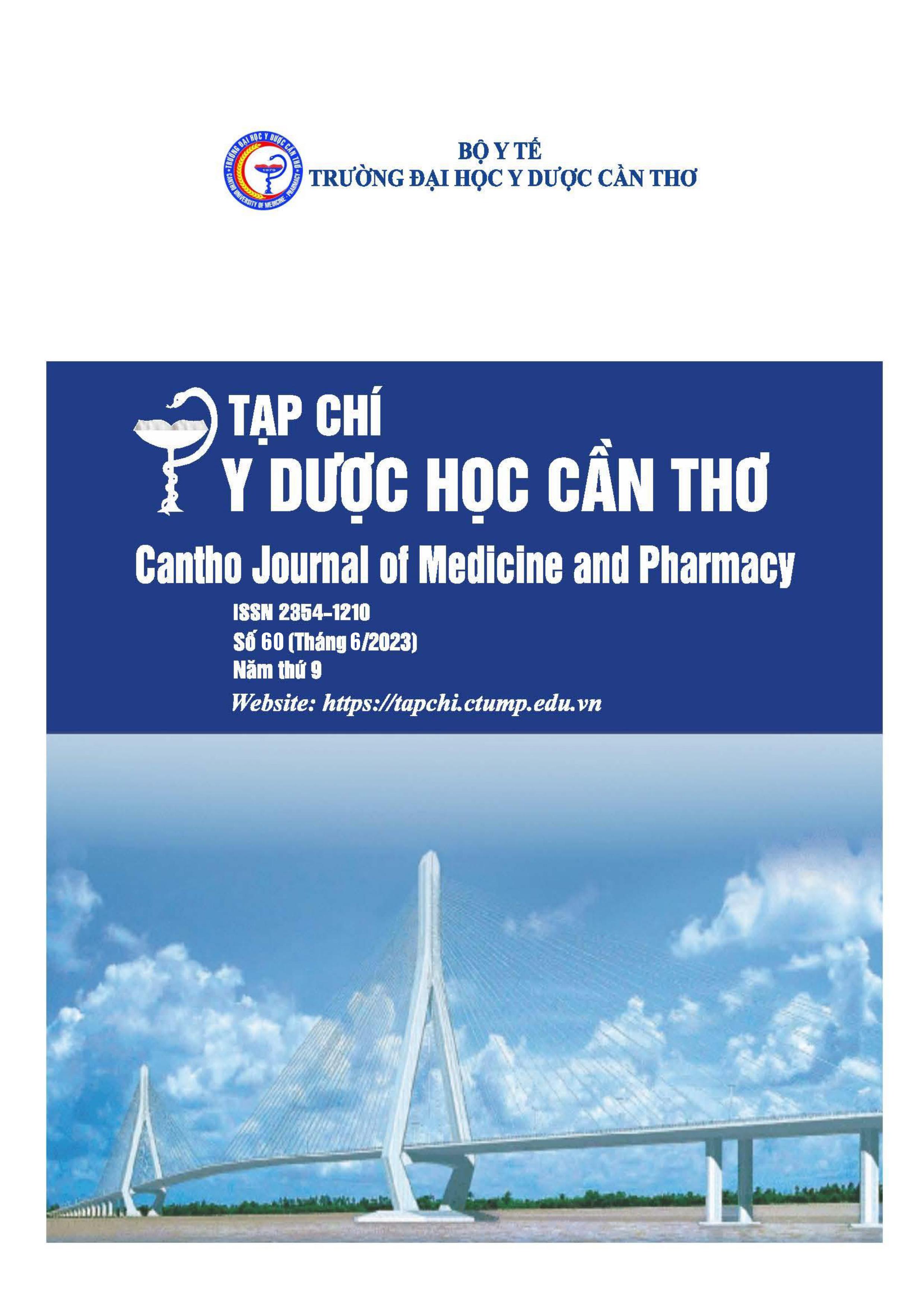KHẢO SÁT TỶ LỆ, ĐẶC ĐIỂM LÂM SÀNG, CẬN LÂM SÀNG, MỘT SỐ YẾU TỐ LIÊN QUAN CỦA HỘI CHỨNG QT KÉO DÀI TRÊN BỆNH NHÂN BỆNH MẠCH VÀNH TẠI TRUNG TÂM TIM MẠCH, BỆNH VIỆN ĐA KHOA TRUNG ƯƠNG CẦN THƠ NĂM 2021- 2023
Nội dung chính của bài viết
Tóm tắt
Đặt vấn đề: Hội chứng QT kéo dài là một rối loạn làm tăng nguy cơ đột tử do rối loạn nhịp nặng trên bệnh nhân bệnh mạch vành. Mục tiêu nghiên cứu: Khảo sát tỷ lệ, đặc điểm lâm sàng, cận lâm sàng và một số yếu tố liên quan của hội chứng QT kéo dài trên bệnh nhân bệnh mạch vành. Đối tượng và phương pháp nghiên cứu: Nghiên cứu mô tả cắt ngang trên 922 bệnh nhân bệnh mạch vành tại Trung tâm Tim mạch, Bệnh viện Đa khoa Trung ương Cần Thơ. Kết quả: Có 59 bệnh nhân mắc hội chứng QT kéo dài (6,4%). Tỷ lệ nữ giới gấp 1,8 lần nam giới. Các yếu tố liên quan có ý nghĩa thống kê là: Nữ giới (p<0,01), BMI thiếu cân (p<0,01), hạ kali máu (p=0,024), hạ canxi máu (p<0,01) và sử dụng nhiều loại thuốc kéo dài khoảng QT (p=0,017). Kết luận: Tỷ lệ QT kéo dài trên bệnh nhân bệnh mạch vành là 6,4% và vấn đề điều trị cần quan tâm các yếu tố liên quan như nữ giới, BMI thiếu cân, hạ kali máu, hạ canxi máu và sử dụng nhiều loại thuốc kéo dài khoảng QT để hạn chế nguy cơ rối loạn nhịp nặng.
Chi tiết bài viết
Từ khóa
Hội chứng QT kéo dài, bệnh mạch vành, QTc, yếu tố liên quan
Tài liệu tham khảo
2. Pye M, Quinn A.C, Cobbe S.M. QT interval dispersion: A non- invasive marker of susceptibility to arrythmia in patients with sustained ventricular arrhythmias?. British Heart Journal. 1994. 71 (6), 511-514, https://doi.org/10.1136/hrt.71.6.511.
3. Knuuti J, Wijins W, Saraste A, Capodano D, Barbato E, et al. 2019 ESC Guidelines for the diagnosis and management of chronic coronary syndromes: The Task Force for the diagnosis and management of chronic coronary syndromes of the European Society of Cardiology (ESC). European Heart Journal. 2020. 41 (3), 407-477.
4. Kazuo K, Takeshi K, Masaharu I, Yoshihisa N, Koichi N, el al. JCS 2018 Guideline on Diagnosis and Treatment of Acute Coronary Syndrome. Circulation Journal. 2018. 1092-1105.
5. Rautaharju P.M, Surawicz B, Gettes L.S, Bailey J.J, Childers R, et al. AHA/ACCF/HRS recommendation for the standardization and interpretation of the electrocardiogram: part IV: the ST segment, T and U waves, and the QT interval: a scientific statement from the American Heart Association Electrocardiography. Journal of America College Cardiology. 2009. 53 (11), 982-991.
6. Mahmud R, Gray A, Nabeebacus A, Whyte M.B. Incidence and outcomes of long QTc in acute medical admissions. International Journal of Clinical Practice. 2018. 72(11), 1-8, https://doi.org/10.1111/ijcp.13250.
7. Nguyễn Vũ Thắng, Phạm Trần Linh. Nghiên cứu đặc điểm biến đổi khoảng QT ở bệnh nhân nhồi máu cơ tim cấp có ST chênh lên tại Viện Tim mạch Việt Nam. Tạp chí Y học Việt Nam. 2020. 495 (2), 59-62.
8. Yu H, Zhang L, Liu J, Liu Y, Kowey P.R, et al. Acquired long QT syndrome in hospitalized patients. Heart Rhythm. 2017. 14 (7), 974-978, https://doi.org/10.1016/j.hrthm.2017.03.014.
9. Tisdale J.E, Wroblewski H.A, Overholser B.R, Kingery J.R, Trujillo T.N, et al. Prevalence of QT interval prolongation in patients admitted to cardiac care units and frequency of subsequent administration of QT interval-prolonging drugs: a prospective, observational study in a large urban academic medical center in the US. Drug Safety. 2012. 35 (6), 459-470, https://doi.org/10.2165/11598160-000000000-00000.
10. Cinca J, Figueras J, Tenorio L, Valle V, Trcnchs J, et al. Time course and rate dependence of Q – T interval changes during noncomplicated acute transmural myocardial infarction in human beings. America Journal of Cardiology. 1982. 1023-1031.
11. Trần Kim Trang, Trị số độ biến thiên QT trong bệnh nhồi máu cơ tim, Tạp chí Y học TP. Hồ Chí Minh. 2003. 7 (1), 58-62.
12. Rautaharju P.M, Zhou S.H, Wong S, Calhoun H.P, Berenson G.S, et al. Sex differences in the evolution of the electrocardiographic QT interval with age. Canadian Journal of Cardiology. 1992. 8 (7), 690-695.
13. Arya A. Gender-related differences in ventricular repolarization: beyond gonadal steroids. Journal of cardiovascular electrophysiology. 2005. 16 (5), 525-527.
14. Numaguchi H, Johnson J.P Jr, Petersen C.I, Balser J.R. A sensitive mechanism for cation modulation of potassium current. Nature Neuroscience. 2000. 3 (5), 429-430, https://doi.org/10.1038/74793.
15. Nguyễn Việt Khoa, Nguyễn Văn Quỳnh. Mối liên quan giữa khoảng QT với hình thái và chức năng thất trái ở bệnh nhân nhồi máu cơ tim cũ. Tổng hội Y học Việt Nam. 2008. Nội khoa tháng 1, 24-30.


